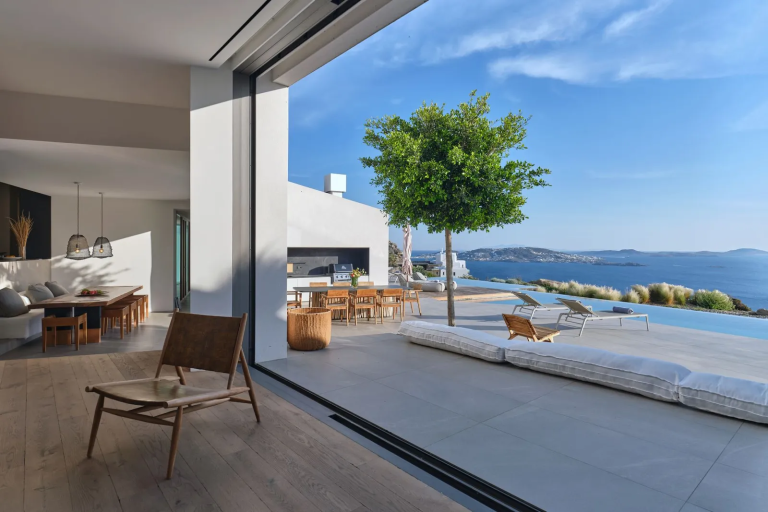
Despina Laou – Greece Sotheby’s International Realty
Pause for a moment, and take a breath. Are you aware of all the ways your senses are being engaged by your surrounding environment?
Color palettes and natural light can evoke moods and emotions, while richly ornamented surfaces can amaze and excite. Sound, scents, and taste also have a subtle yet profound effect on your well-being. And how you feel emotionally is partly determined by what you’re feeling physically, which is why touch and texture are so crucial.
Architects, decorators, and landscapers are becoming ever more aware of the synergies between the sensory elements in the spaces they create—and today, the engagement of sight, sound, scent, taste, and touch are key factors in fashioning and furnishing luxury homes.
This is known as “sensory design.” At a time when homeowners are increasingly focused on wellness, it’s an emerging trend that promises serious staying power. Here’s why it’s essential to consider each sensory element in home design, as well as a best-in-class example of how it can be done with excellence.
Sight
Despina Laou – Greece Sotheby’s International Realty
Colors and patterns can cause or alleviate stress. But although soft hues, soothing neutrals, and natural shades are typically associated with relaxation, remember that their impact is subjective and can be customized according to personal needs.
Despina Laou – Greece Sotheby’s International Realty
There are many other ways sensory design engages the sense of sight, as demonstrated by this hillside villa near Mykonos. The size and location of windows—as well as their window dressings—helps control the abundance and quality of light, as do lighting fixtures and their shades.
The views through those windows, as well as access to the outdoors, are also vital. With its vast patio and breathtaking sightlines, calming organic tones, and elimination of clutter through efficient storage, few homes prioritize visuality in such a thoughtful way.
Sound
Guy Bradshaw – United Kingdom Sotheby’s International Realty
Both sound and silence contribute to effective sensory design. Spaces may be built to maximize acoustics, or they may be soundproofed to minimize noise. And though it may be counterintuitive, auditory installations can actually help improve a home’s tranquility—just think of the serene ambience cultivated by a shishi-odoshi bamboo fountain.
Guy Bradshaw – United Kingdom Sotheby’s International Realty
Water features, acting as conduits to replicate the peaceful soundscape of the natural world, are important factors in the sonic and aesthetic design of this contemporary country house close to Windsor Castle. With approximately 10 acres of pristine woodland and an award-winning garden, soothing sounds abound outdoors—and indoors, integrated audio technology allows homeowners to bring music into their living space as they please.
Scent
Christopher Muller – Luxembourg Sotheby’s International Realty
The sense of smell is as fundamental to the aesthetics of a home as seeing and hearing. After all, the part of your brain that processes scent is contiguous with the regions responsible for memories, associations, and emotions, making this the most evocative of your senses.
Christopher Muller – Luxembourg Sotheby’s International Realty
There are many ways to optimize scent through sensory design. For example, materials such as cedar and eucalyptus have naturally pleasant odors, while candles and diffusers can enhance a space’s aromatherapeutic qualities. This luxurious loft apartment in Luxembourg-Dommeldange follows another best practice by nurturing ornamental greenery that purifies the air.
Along with fragrant vegetation, high-performance insulation and dual-flow ventilation keep the interiors of the home fresh and pollutant-free.
Taste
Agnes Pinaire – Propriétés Parisiennes Sotheby’s International Realty
The kitchen is the heart of any home, and is a high-traffic hub of gathering and activity. It’s also the area where the flavors of a favorite snack or a family recipe come alive, and where the sense of taste is most readily engaged. So the question is, can sensory design moderate this space without detracting from its deliciously one-of-a-kind character?
Agnes Pinaire – Propriétés Parisiennes Sotheby’s International Realty
With gourmet appliances, ample cabinetry, and vibrant yet muted light shades in an eclectic mix of earth tones, this remarkable residence tucked away in the heart of Paris has the type of kitchen designed for good taste—literally and figuratively. Other sensory-forward features are its multiple dining areas—one that extends from the kitchen, and a second more formal setting—as well as a designated wine cellar on the basement level.
Touch
Ged Hay and Nadia Hay – New Zealand Sotheby’s International Realty
Whether it’s comfortable furniture, cozy rugs, plush upholstery, or abundant cushions and pillows, fabrics have always played a palpable role in sensory design for touch. But softness isn’t a prerequisite for a rich and rewarding haptic experience.
Ged Hay and Nadia Hay – New Zealand Sotheby’s International Realty
Materials like wood, granite, and marble are highly tactile and engaging to the senses, and are used to great effect in this unique estate perched amid the mountains of New Zealand’s Motueka Valley. Red cedar and oak, as well as magnificent mantles of locally sourced stone, lend it the tangible warmth and charm of a European lodge. And since effective climate controls are another way to satisfy the sense of touch, all three of its fully equipped suites have fireplaces and air conditioning.
When homes are crafted to engage all five senses, they elevate the well-being of all who inhabit them. By intentionally and unobtrusively augmenting the sights, sounds, scents, tastes, and textures of living spaces, sensory design unlocks a whole new level of lifestyle.